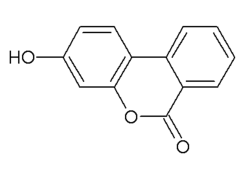Urolithin B
 | |
| Names | |
|---|---|
| IUPAC name
3-hydroxybenzo[c]chromen-6-one | |
| Other names
Uro-B 3-Hydroxyurolithin | |
| Identifiers | |
| 1139-83-9 | |
| 3D model (Jmol) | Interactive image |
| ChEMBL | ChEMBL1526978 |
| ChemSpider | 4528673 |
| ECHA InfoCard | 100.236.446 |
| PubChem | 5380406 |
| |
| |
| Properties | |
| C13H8O3 | |
| Molar mass | 212.21 g/mol |
| Except where otherwise noted, data are given for materials in their standard state (at 25 °C [77 °F], 100 kPa). | |
| Infobox references | |
Urolithin B is an urolithin, a type of phenolic compounds produced in the human gut after absorption of ellagitannins-containing food such as pomegranate,[1] strawberries, red raspberries, walnuts or oak-aged red wine.[2] Urolithin B is found in the urine in the form of urolithin B glucuronide.
See also
References
- ↑ Bialonska D, Kasimsetty SG, Khan SI, Ferreira D (11 November 2009). "Urolithins, intestinal microbial metabolites of Pomegranate ellagitannins, exhibit potent antioxidant activity in a cell-based assay". J Agric Food Chem. 57 (21): 10181–6. doi:10.1021/jf9025794. PMID 19824638.
- ↑ Cerdá, Begoña; Tomás-Barberán, Francisco A.; Espín, Juan Carlos (2005). "Metabolism of Antioxidant and Chemopreventive Ellagitannins from Strawberries, Raspberries, Walnuts, and Oak-Aged Wine in Humans: Identification of Biomarkers and Individual Variability". Journal of Agricultural and Food Chemistry. 53 (2): 227–235. doi:10.1021/jf049144d. PMID 15656654.
External links
This article is issued from Wikipedia - version of the 6/6/2016. The text is available under the Creative Commons Attribution/Share Alike but additional terms may apply for the media files.